In November 1855, the Great Ansei Earthquake struck the city of Edo (now Tokyo), claiming 7,000 lives and inflicting widespread damage. Within days, a new type of color woodblock print known as namazu-e (lit. "catfish pictures") became popular among the residents of the shaken city. These prints featured depictions of mythical giant catfish (namazu) who, according to popular legend, caused earthquakes by thrashing about in their underground lairs. In addition to providing humor and social commentary, many prints claimed to offer protection from future earthquakes.
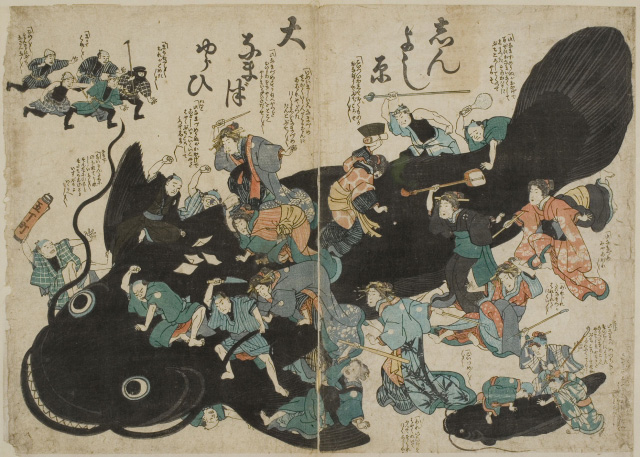
1. Earthquake victims take revenge on the giant catfish responsible for the destruction [+]
The popularity of namazu-e exploded, and as many as 400 different types became available within weeks. However, the namazu-e phenomenon abruptly ended two months later when the Tokugawa government, which ordinarily maintained a strict system of censorship over the publishing industry, cracked down on production. Only a handful are known to survive today.
* * * * *
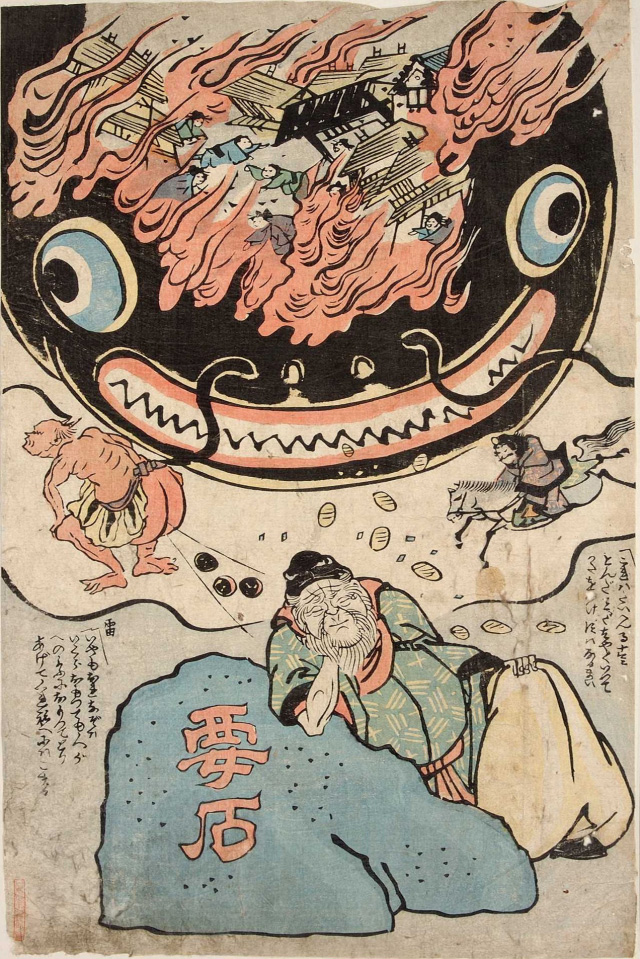
2. Namazu and the kaname-ishi rock [+]
Namazu are normally kept under control by the god Kashima using a large rock known as kaname-ishi. The Great Ansei Earthquake of 1855 is said to have occurred when Kashima went out of town and left Ebisu (god of fishing and commerce) in charge. In this print, the giant subterranean catfish unleashes destruction on the city while Ebisu sleeps on the job. Kashima rushes home on horseback while the city burns, and Raijin the thunder god defecates drums. Large gold coins fall from the sky, symbolizing the redistribution of wealth during the rebuilding phase.
* * * * *
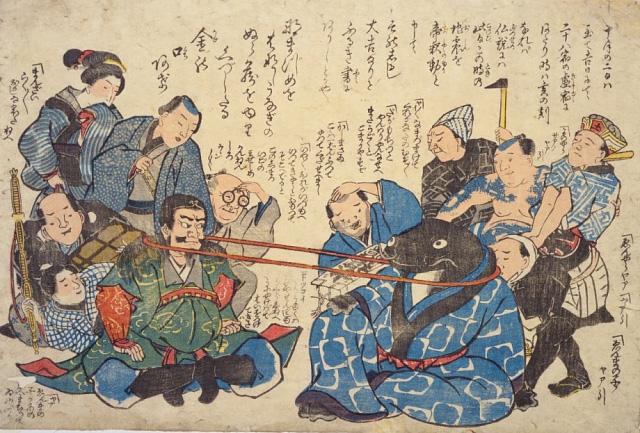
3. Tug-of-war between namazu and the god Kashima [+]
This print shows a namazu engaged in a fierce game of "neck tug-of-war" with the god Kashima. A group of earthquake victims root for Kashima, while those who typically profit from earthquakes (construction workers, firemen, news publishers, etc.) root for the catfish.
* * * * *
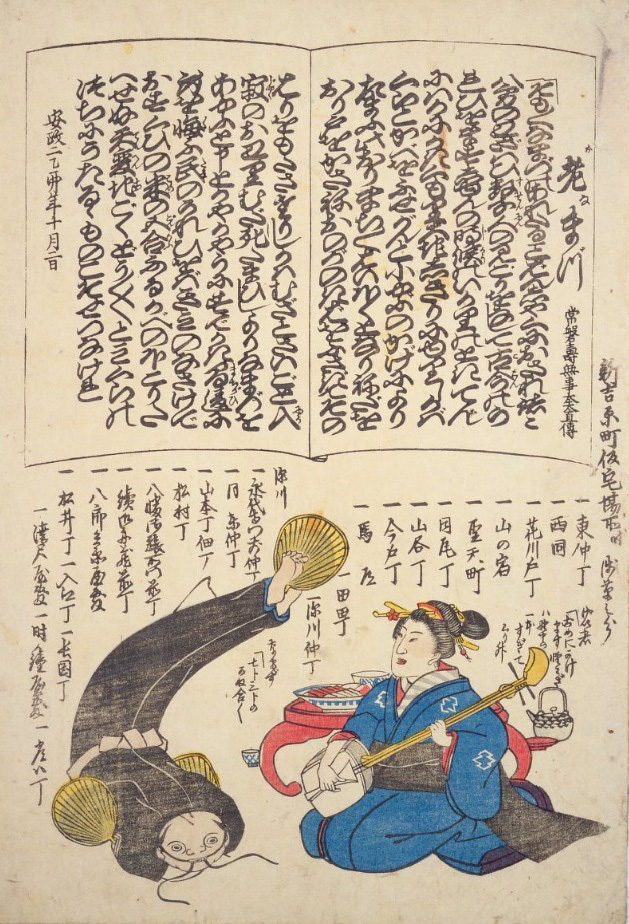
4. Ancient catfish (Artists: Kyosai Kawanabe and Robun Kanagaki)
Produced two days after the earthquake, this work by Kyosai Kawanabe and Robun Kanagaki is considered the first namazu-e catfish print. The picture, which makes reference to a popular kabuki play of the era, inspired the creation of many namazu-e prints to follow.
* * * * *
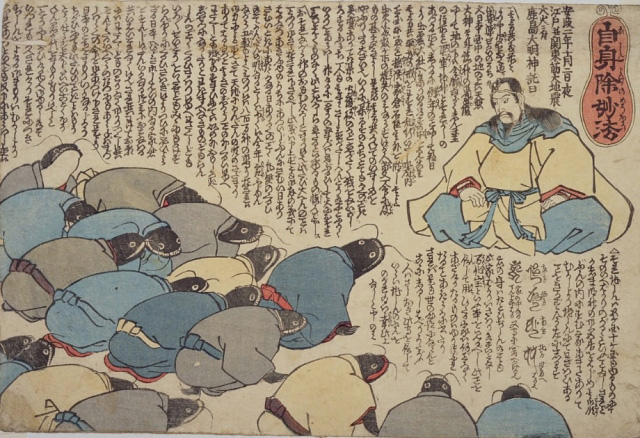
5. Magical method of earthquake protection [+]
This protective print, which claims to prevent earthquake damage to one's home if attached to the ceiling, shows a group of remorseful catfish apologizing to the god Kashima for causing earthquakes while he was away.
* * * * *

6. Catfish family
This print shows a mob of earthquake victims coming to take revenge on a namazu and its children.
* * * * *
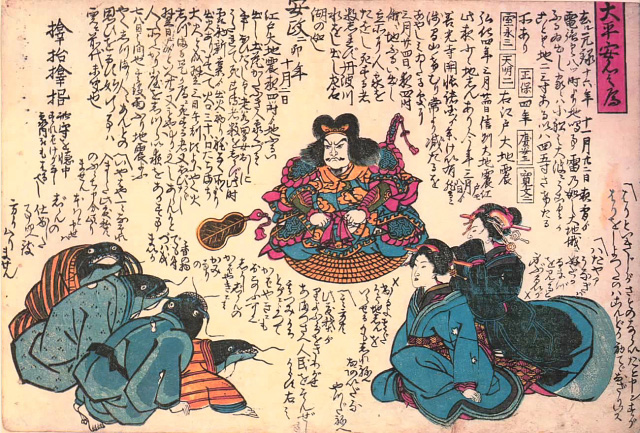
7. For peace and tranquility [+]
In this print, which claims to offer protection from earthquakes, the god Kashima and prostitutes from the Yoshiwara red-light district express their anger toward the catfish responsible for earthquakes.
* * * * *
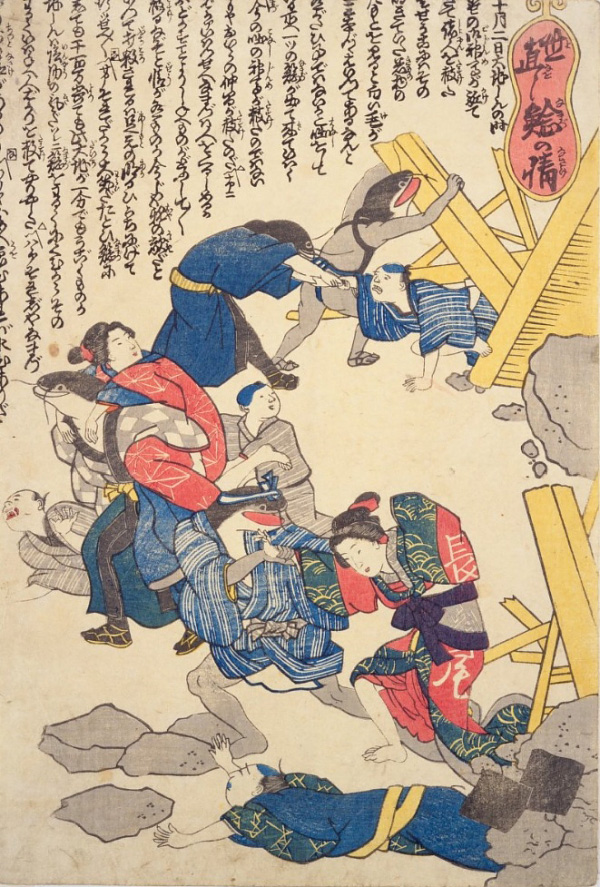
8. Namazu saviors
Some prints show the benevolent side of namazu. Here, they are seen rescuing people from the rubble.
* * * * *
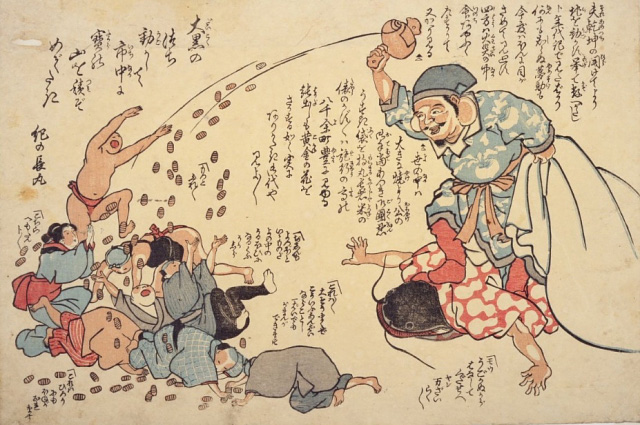
9. Daikoku, the popular god of wealth, restrains a namazu and showers people with money [+]
* * * * *
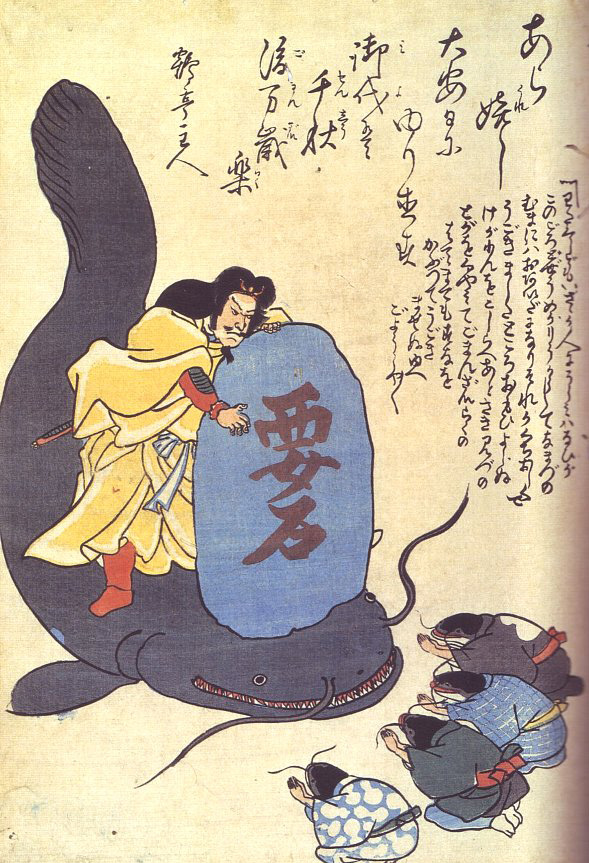
10. Kashima restrains a namazu using the kaname-ishi rock
* * * * *
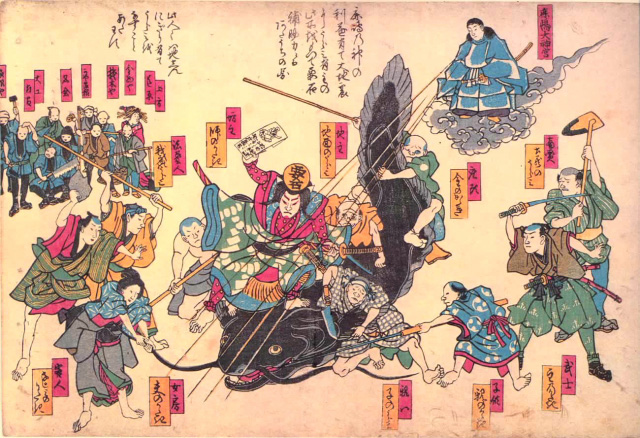
11. Kashima, kaname-ishi, and namazu [+]
In this print, the god Kashima is pictured in the top right corner. The kaname-ishi rock, portrayed as a person, stands on the head of the catfish, while a crowd of people try to subdue the giant beast. The people on the left who are not helping subdue the catfish include construction workers and others who typically profit from earthquakes.
* * * * *
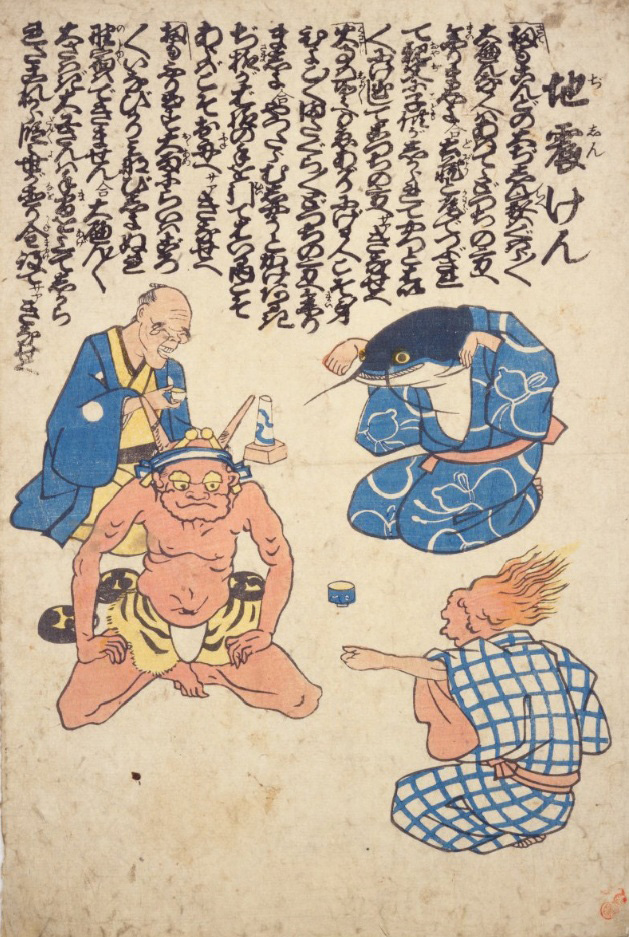
12. Earthquake hand game
This print is a reference to the old Japanese saying, "The most frightening things are earthquakes, thunder, fires, and fathers." Here, a namazu plays janken (paper-rock-scissors) with the gods of thunder and fire while an elderly man (father) looks on.
* * * * *
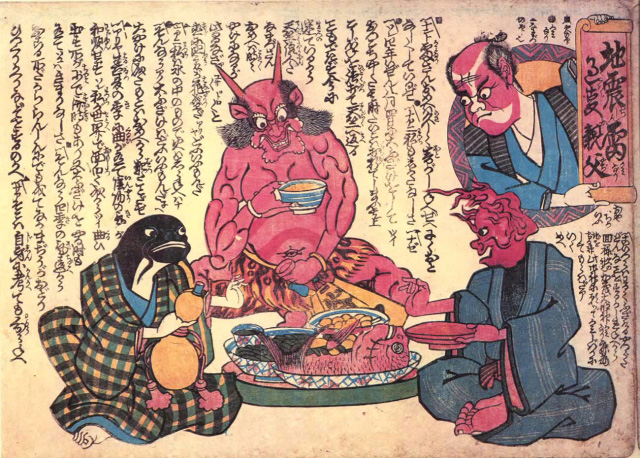
13. Earthquakes, thunder, fires and fathers [+]
This print also makes reference to the old Japanese saying, "The most frightening things are earthquakes, thunder, fires, and fathers." Here, a namazu and the gods of thunder and fire discuss their powers over a fish dinner while a middle-aged man (father) looks on.
* * * * *

14. Tipsiness following the great namazu [+]
In this print, the god Kashima stabs his sword into the throat of the namazu, which is laid out on a giant table. The crowd of onlookers is divided into two groups. The people in the top half of the picture are labeled as "smiling" (those who benefit from the earthquake) and the people at the bottom are labeled as "weeping" (those who are harmed by the earthquake). The top group includes a carpenter, a plasterer, a lumber salesman, a blacksmith and a roofer, as well as an elite courtesan, an ordinary prostitute, a physician, and sellers of ready-to-eat foods. The bottom group includes a teahouse proprietor, an eel seller, various entertainers such as musicians, comedians and storytellers, a seller of luxury goods, a diamond seller, and a seller of imported goods.
* * * * *
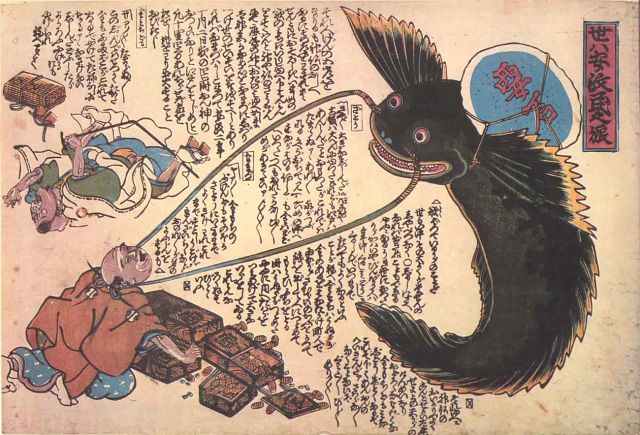
15. Prosperity of the Ansei era [+]
This print, which shows a namazu punishing a rich man and a famous actor, illustrates a popular theory that the gods deliberately allowed the earthquake to happen in order to rectify some of the imbalances in the world.
* * * * *
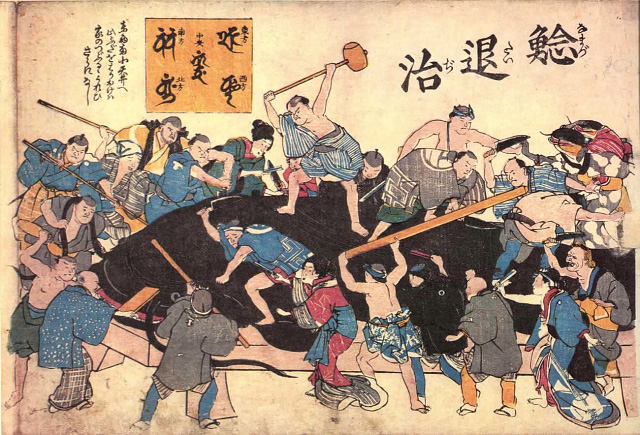
16. Namazu attacked by the citizens of Edo [+]
* * * * *

17. Catfish and construction workers partying in the Yoshiwara red-light district, pt. 1 [+]
This print depicts a crowd of namazu and newly prosperous construction workers living it up at a parlor house in the Yoshiwara pleasure district.
* * * * *
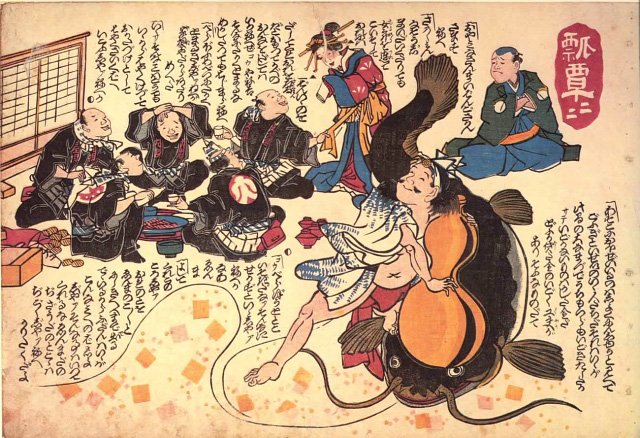
18. Catfish and construction workers partying in the Yoshiwara red-light district, pt. 2 [+]
This print also shows carpenters, plasterers and roofers drinking and making merry in the Yoshiwara pleasure district while a namazu is restrained with a gourd.
* * * * *
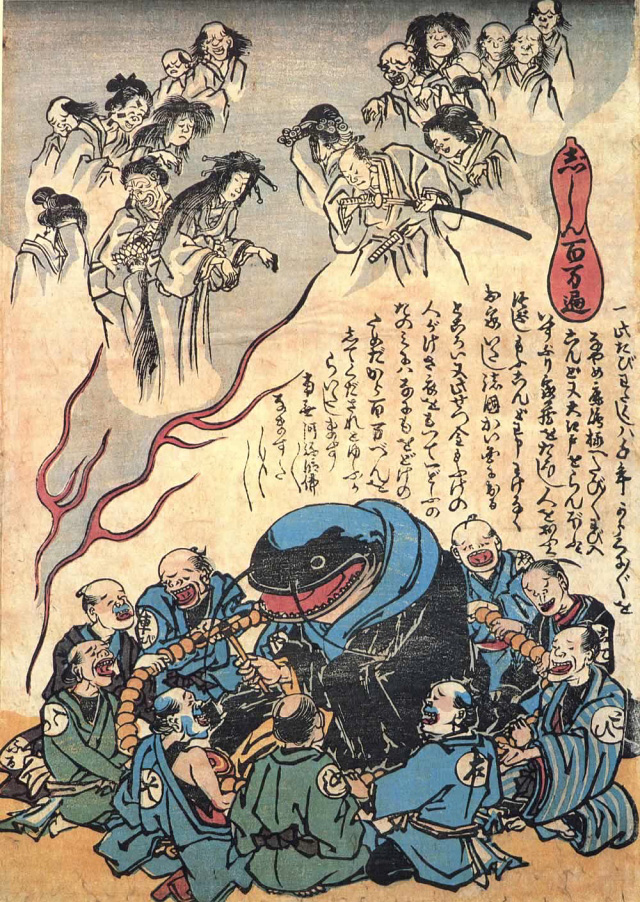
19. The earthquake and a "million prayers" [+]
This print depicts a namazu as a priest seated inside a giant rosary. The creature does not want to cause any more earthquakes, but the "worshipers" -- tradesmen such as lumber dealers and carpenters who profit from the disaster -- are praying for it to act up again. The ghosts of earthquake victims float overhead.
* * * * *
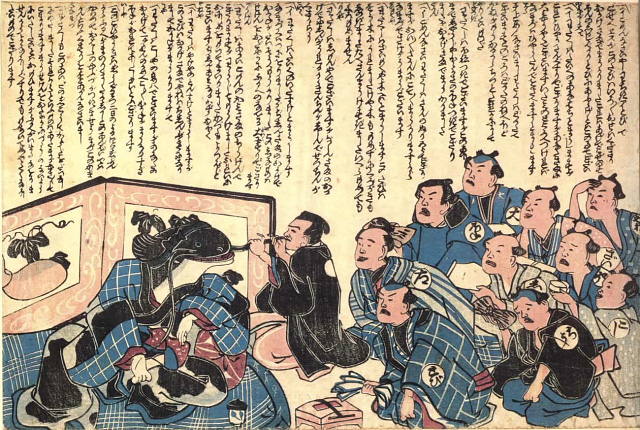
20. Earthquake catfish and world rectification [+]
In this print, a group of construction workers pay respect to the namazu for helping them strike it rich.
* * * * *
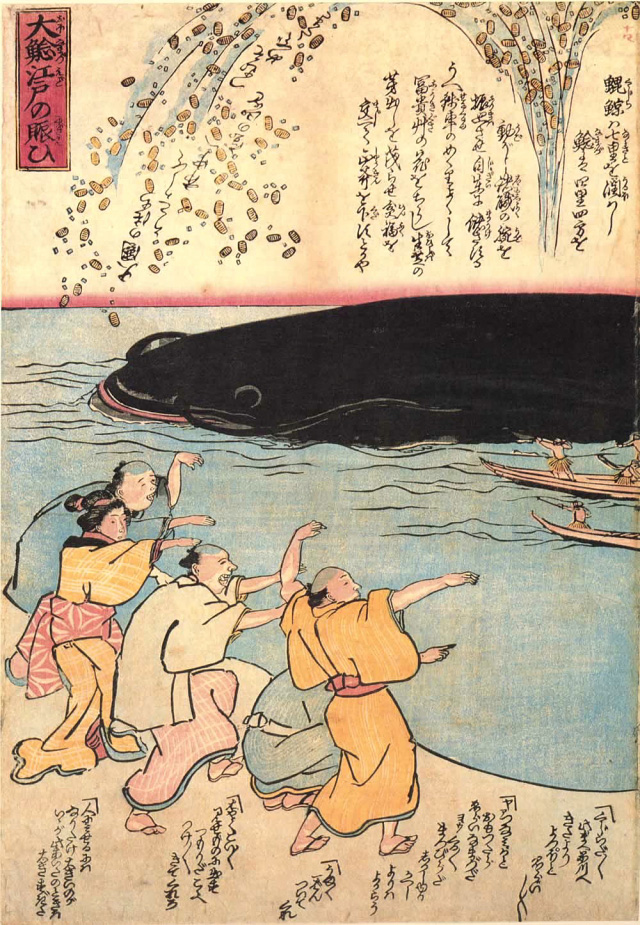
21. The shaking of greater Edo [+]
This print shows a massive steamship-like namazu approaching the city. The creature is spouting money, and people on shore beckon for it to come closer. The depiction of this namazu conjures up images of Commodore Perry's black ships, which arrived in Japan in 1853 and eventually forced the country to open its ports to Western commerce.
* * * * *
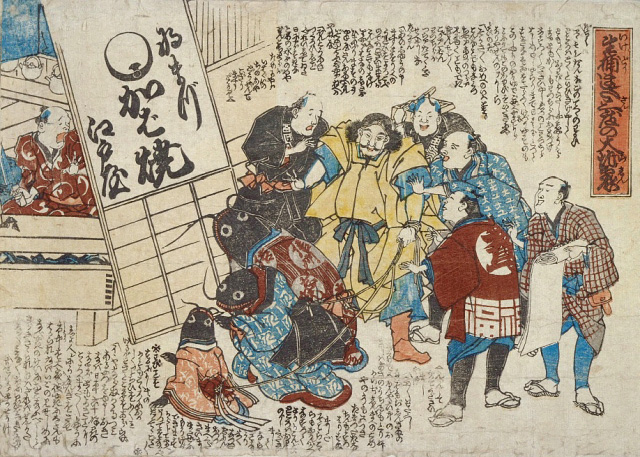
22. The perpetrators of three big quakes captured alive [+]
In this print, the god Kashima has captured the catfish responsible for the major earthquakes in Shinshu, Edo, and Odawara. A carpenter, fireman, plasterer and roofer try to persuade the god to release the catfish, saying the creatures have apologized enough. The unforgiving Kashima sentences the fish to be cooked in a nabe stew.
* * * * *
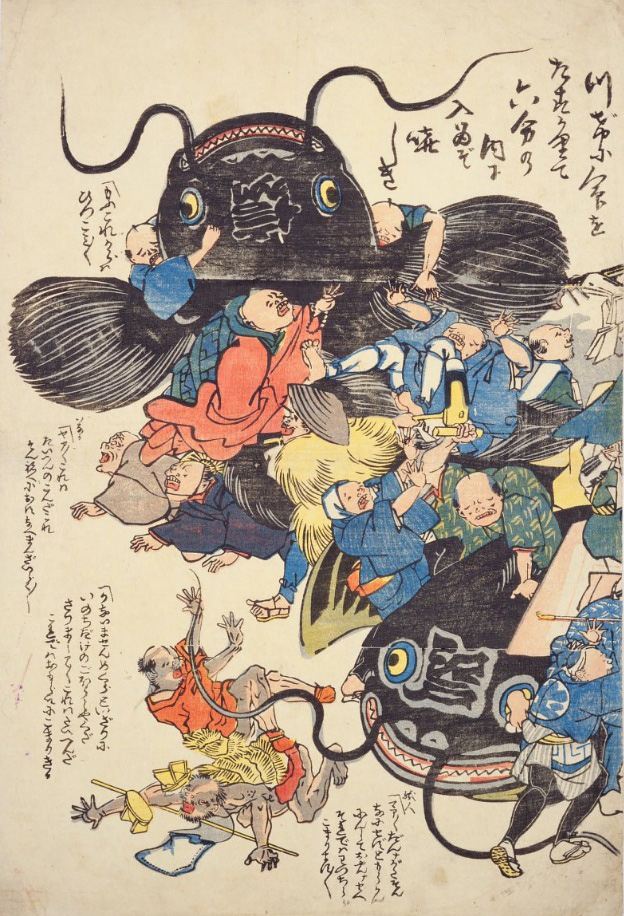
23. Namazu of Edo and Shinshu
* * * * *
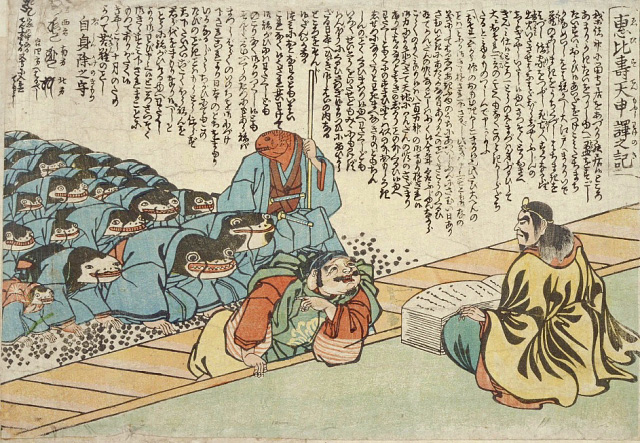
24. Ebisu apologizes [+]
In this print, Ebisu (god of fishing and commerce) apologizes to Kashima for falling asleep on the job after drinking. The catfish leader is also apologizing, saying it was the thoughtless ones that went wild.
* * * * *
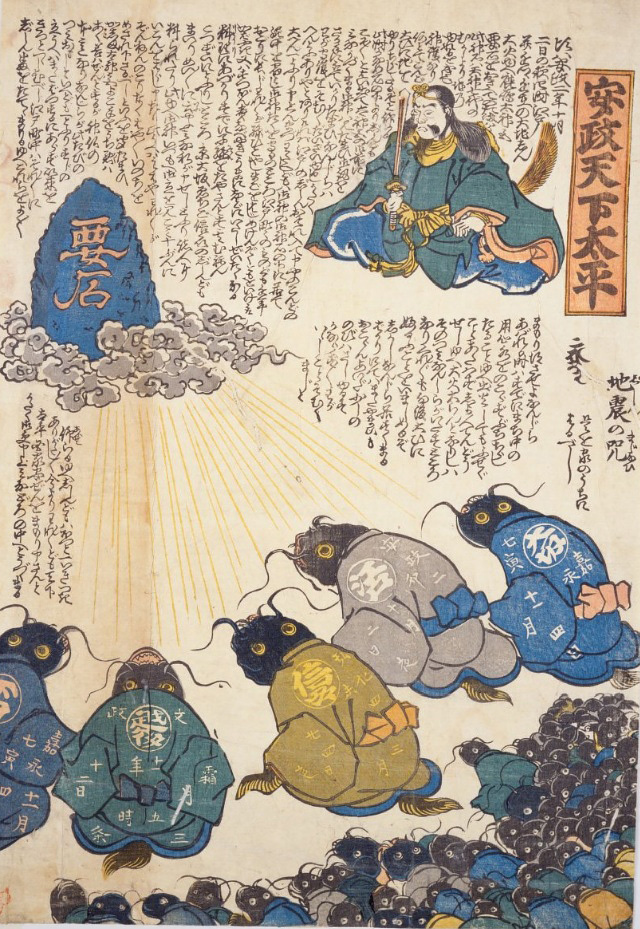
25. Peace in the Ansei era
This print shows the god Kashima using the kaname-ishi to subdue the namazu responsible for the recent earthquakes.
* * * * *
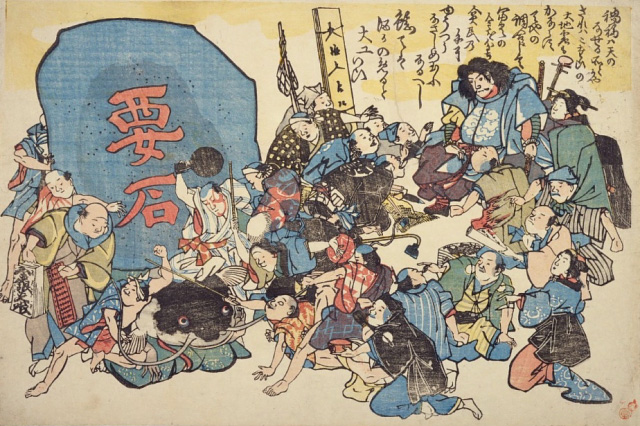
26. Namazu is wrestled into submission and placed under the kaname-ishi rock [+]
* * * * *

27. Ridgepole raising
This print shows a group of namazu construction workers erecting the kanji character 平 (hira), which can symbolize "peace."
* * * * *

28. A man entertains a namazu [+]
* * * * *
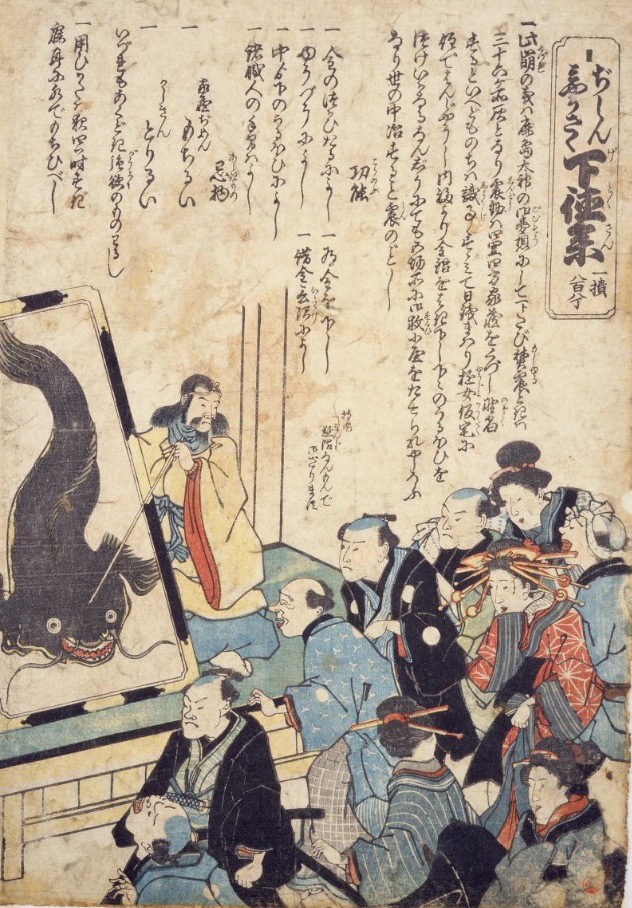
29. People inspect a namazu picture
* * * * *

30. Monster namazu in the storehouse [+]
* * * * *

31. Gourd and catfish
In this print, a namazu tries to help a comrade escape from a trap by handing it a gourd. The image is a reference to the old Japanese expression "gourd and catfish" (meaning "slippery" or "elusive"), which originates from a famous 15th-century Zen painting of a man trying to catch a catfish with a gourd.
* * * * *
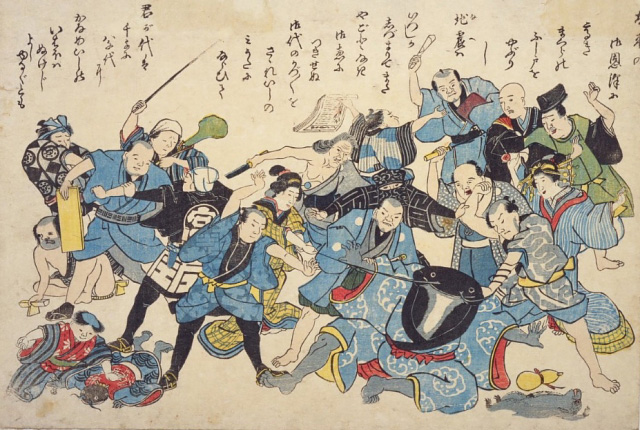
32. Mob takes revenge on a namazu [+]
* * * * *
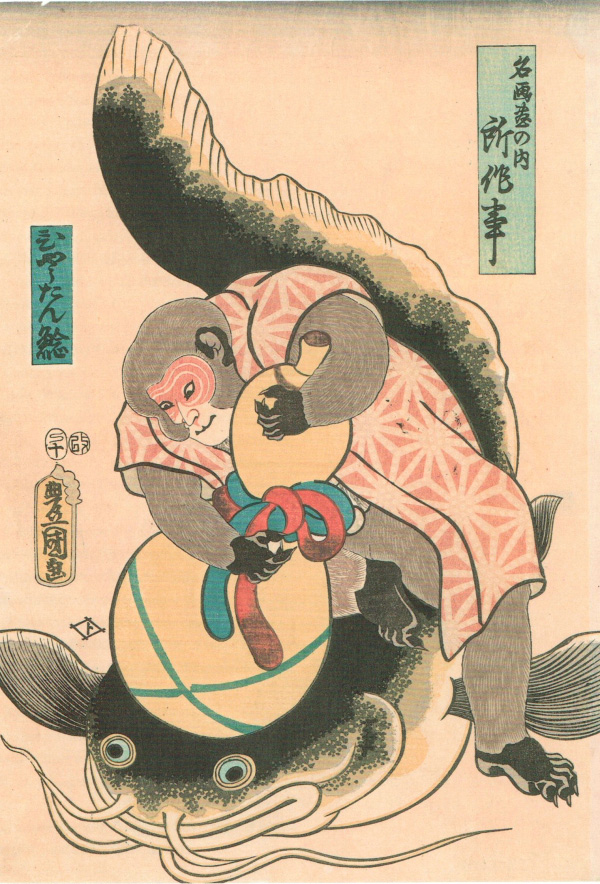
33. Catching a catfish with a gourd (Artist: Kunisada Utagawa) [+]
* * * * *
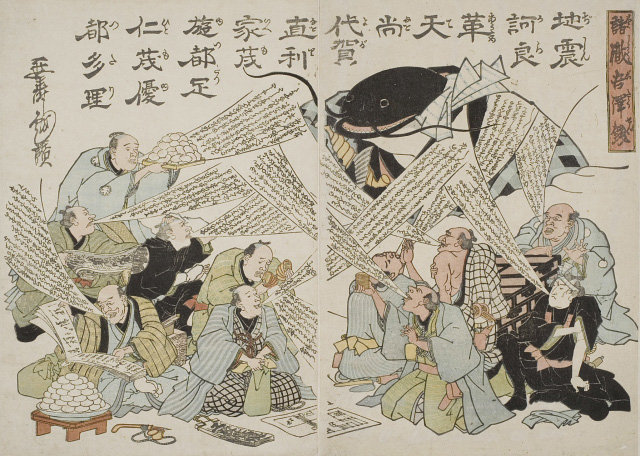
34. People who profit from earthquakes make offerings to a namazu [+]
* * * * *
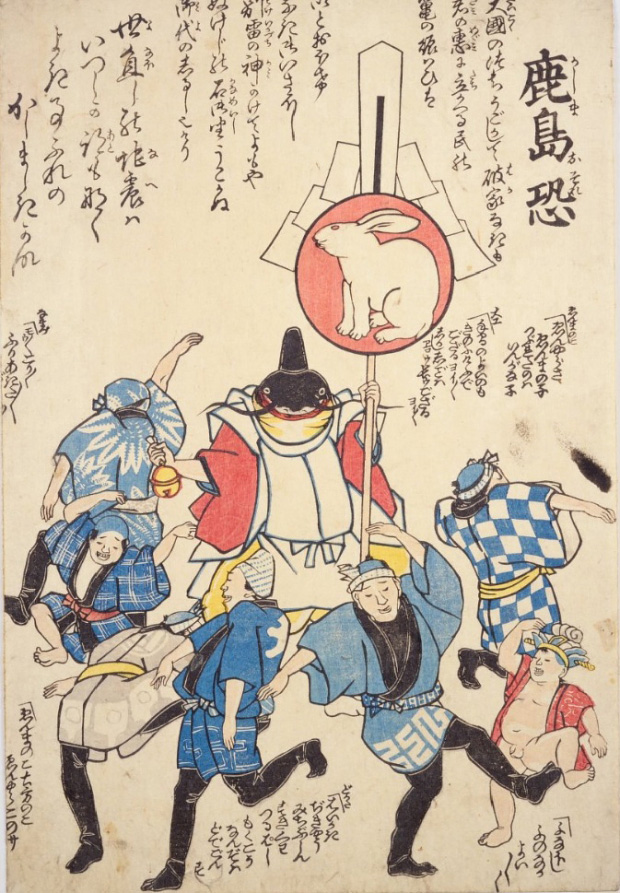
35. Fear of Kashima
This print shows people dancing around a namazu dressed as a representative of Kashima shrine in an annual ritual held before the start of the new agricultural season. The image of the rabbit represents the zodiac year of the rabbit (1855).
* * * * *
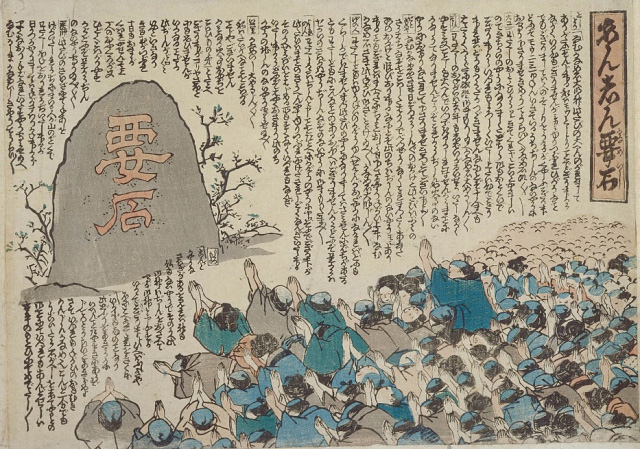
36. Reassurance of the quake-suppressing rock [+]
A crowd of elderly people, carpenters, young wives, china-shop owners, entertainers, Yoshiwara prostitutes, physicians, and others are offering prayers to the kaname-ishi rock, believed to have the power to keep earthquakes in check. When a person in the crowd voices his doubts about the rock's powers, the rock responds, "I assure you that if the earth moves even a little I will stand on my head." In the original Japanese, this answer features a pun on the words ishi-gaeshi ("overturning a rock") and ishu-gaeshi ("taking revenge").
* * * * *

37. Earthquake protection song
In this print, Daikoku, the popular god of wealth, showers people with money while the god Kashima restrains a namazu.
* * * * *
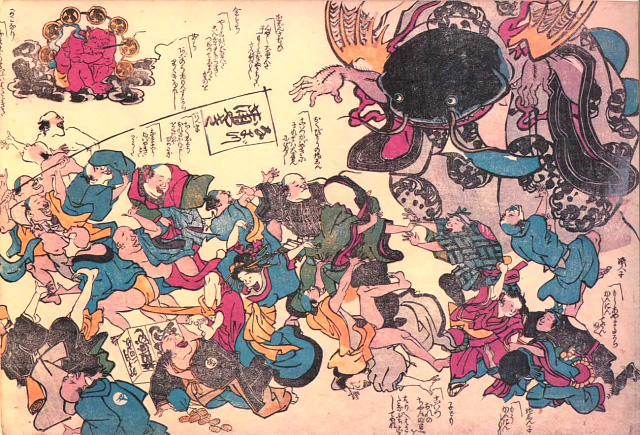
38. Frightened namazu [+]
This print shows a mother namazu chasing a mob of people who have kidnapped her two children. The message on the flag carried by a person in the crowd suggests they intend to grill and eat the young catfish.
* * * * *
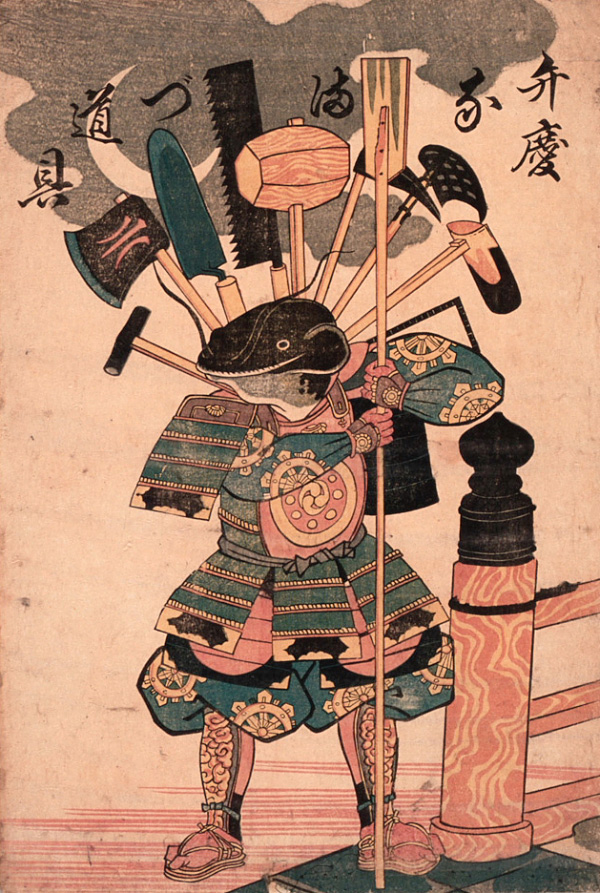
39. Namazu with construction tools, portrayed as the legendary warrior Benkei
* * * * *
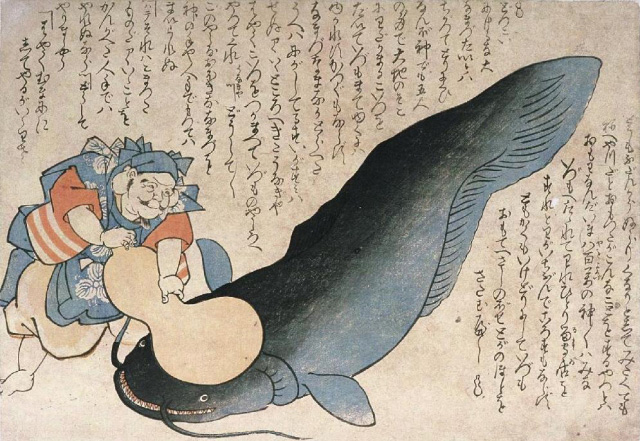
40. The god Ebisu restrains a giant catfish with a gourd [+]

Armin
Every post in here is a real treat! Thanks for sharing this wonderful works!
[]Zuza
I was looking for namazu-e just a few days ago, thanks for posting so many! Explanations say a lot about the society of that time - I hope this time entertainers won't be affected by the quake too much.
[]Norek
One of the best entries I've seen here.
[]Keep up the good work!
sublight
Great collection! Interesting that even back then news publishers were seen as being on the side of chaos and destruction.
[]DW
I find this fascinating, too. And very modern! If the same artists were alive and making namazu-e today, they would undoubtedly show the sensationalist foreign media worshipping the namazu.
BTW, in picture #32 you can see a few people trying to stop the mob from attacking. One of them appears to be a newspaper seller.
[]Richard
Great article! I would love to get/make a print of #10. Can you tell me where that came from?
[]1GAE
Absolutely fascinating stuff, another great blog entry. Thank you for your hard work. Seems like namazu won a few rounds of janken lately.
[]yokohamamama
*Excellent* post! Informative and very well researched! Beautiful, clear shots of the namazu-e, too. I was going to write a post about the Namazu-e myself, but decided just to send everybody over here to you!
(@DW-- "...they would undoubtedly show the modern sensationalist foreign media worshiping the Namazu..." No doubt! That made me laugh :-))
[]NAOKO SATOU
Thank you very mach.
[] åˆã‚ã¾ã—ã¦ã€ã“ã‚“ã«ã¡ã¯ã€‚
日本ã®æ±Ÿæˆ¸æ™‚代ã®è²´é‡ãªåœ°éœ‡é¯°çµµã‚’沢山見る事ãŒå‡ºæ¥ã¦ã€ã¨ã¦ã‚‚å‚考ã«ãªã‚Šã¾ã—ãŸã€‚ã©ã†ã‚‚有難ã†ã”ã–ã„ã¾ã™ã€‚ã©ã†ãžã€ã“ã‚Œã‹ã‚‰ã‚‚ã“ã®ã‚µã‚¤ãƒˆãŒæœ«æ°¸ã続ãã¾ã™ã‚ˆã†ã«ã€‚é ‘å¼µã£ã¦ä¸‹ã•ã„ã¾ã›ã€‚ä½è—¤ç›´å JAPAN
Andrea
Just amazing! Thanks for posting so many namazu-e. I am a geophysicist, in 2009 I have been in Japan and I was looking for buying a copy of a namazu-e, but could'nt find any...Do yuo know where I can buy it?
[]Siddhartha Joshi
Every single image and the story behind it is amazing, am learning about Japan from your blog now! This place simply rocks!!!
[]Michelle Heeter
Thank you so much for sharing these namazu-e. I lived in Japan a long time ago (was there for the Great Hanshin Earthquake in Kobe, 1995).
[]margie
i have named one of my cats namazu...and believe he is a rambunctious furball
[]adventureR
Just made a catfish carving for my Tenkara rod as a line holder. Namazu was my inspiration.
[]Gwen
A little redrawn, for the fun :
[]http://www.flickr.com/photos/gwendalcentrifugue/6329007092/in/photostream
(Tour blog is great by the way :) )
Alex Dubcheck
This post is just great.
[]Can I translate it in Italian with pictures and all on my blog,
obviously mantaining your credits ?
There are too few articles like this in my language
MitreSquareMurder
Hey there!
I used a number of these images in my post about Namazu. You can find the post here: http://mitresquaremurder.blogspot.com/2012/05/death-to-earthquake-causing-catfish.html
I credited you and linked back, so I hope you don't mind.
[]Thanks so much!
Marek
Wow, great article! Can you actually read the texts in the prints?
[]What happened to the blog by the way?